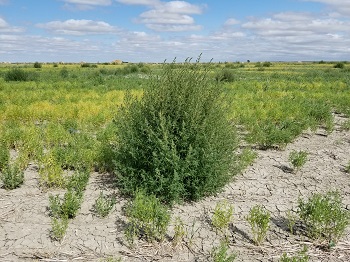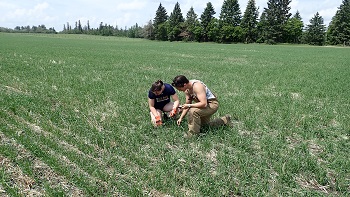Set up an interview
Media Relations
Agriculture and Agri-Food Canada
1-866-345-7972
aafc.mediarelations-relationsmedias.aac@agr.gc.ca
Whether it’s disease, weeds or insects, there are a lot of pests ready to prey on crops. And to complicate matters, there’s also the interplay between pests, environmental factors and farming practices.
That’s a lot of information for prairie farmers and scientists to process, but nobody has to do it alone – not when there’s a multitude of people monitoring these factors and making recommendations on how to best handle the pests.
That’s where networking comes in.
The big picture: biovigilance
Biovigilance is a multi-disciplinary approach to understanding crop pests and how farming and environmental factors can affect them. It’s a continuous evaluation cycle of integrated pest management that ensures that fixing one problem doesn’t create another in the agroecosystem.
To do that on the vast prairie growing region, scientists from academia, AAFC, provincial governments, stakeholder groups and producers share information and track changes in crops.
While the pest-specific networks emphasize timely, farmer-focussed, practical information, the Prairie Biovigilance Network, led by Brent McCallum of the Morden Research and Development Centre, has longer-term goals that overarch all three pest areas. This network hopes to build bridges within the relevant scientific communities, fill in gaps (such as genetic analysis of pest populations), and establish stable funding for biovigilance research.
“When you look at all these networks, the key theme is collaboration. Whether we’re looking for specific predictive forecasts on a weekly basis, or trying to integrate the interplay of all the various pests, environmental factors and farming practices over the long haul, it boils down to sharing information to make Prairie agriculture more efficient and resilient.”
- Dr. Brent McCallum, research scientist
Insects on the prowl
The Prairie Pest Monitoring Network has been around since 1997. Over the years, the goal has remained much the same, with insect monitoring and research projects studying insect population dynamics and now, insecticide resistance.
The network is comprised of field crop entomologists from federal and provincial governments as well as universities, who conduct research and actively monitor to support crop protection on the Canadian prairies. Industry stakeholders provide input, volunteer their time and fields for sampling and collaborate via working groups.
As with the other networks, one of their great successes has been in presenting data in a meaningful way. Field guides, which provide detailed photos of insects, life cycle information and economic threshold data (that is, the point at which a producer should address the pest) act as textbooks for agronomists and farmers. Monitoring protocols give an idea of how to scout for insect pests, and risk maps provide insect warnings and forecasts for different areas of the Prairies. During the growing season, AAFC scientists Dr. Meghan Vankosky (Saskatoon) and Jennifer Otani (Beaverlodge) give weekly updates to help the agriculture industry stay ahead.
Weed watching
The Prairie Weed Monitoring Network operates in much the same fashion as the insect network, with weed specialists from governments and academia working together with industry. Their goal is to provide producers accurate information on weed monitoring, mitigation and management. In 2024, they launched a new website to house this data. Dr. Charles Geddes (Lethbridge) and Julia Leeson (Saskatoon) are key leads for the network. The Prairie Weed Monitoring Network website also has links to all the very detailed Annual Prairie Weed Survey reports that have tracked weed abundance and spread in the Prairies over the years.
In terms of weeds, one of the most important issues facing the agriculture industry is herbicide resistance – the evolved and inherited ability of a plant to survive and reproduce following exposure to a dose of herbicide normally lethal to the wild type. Canada is home to the third largest number of unique herbicide-resistant weed biotypes, surpassed only by the United States and Australia. This is why the network’s surveys and maps of herbicide resistance are so important – knowing which weed species are resistant and where they are spreading from is key for farmers to implement management strategies.
Disease spread
If insects and weeds aren’t enough, there is still another type of pest: disease. Weather plays a big role in which diseases affect yield from year to year, as most diseases thrive in moist conditions (such as fungal diseases like fusarium head blight), while others only need relatively high humidity, heavy dew formation and less frequent rainfall (such as cereal rusts and powdery mildew). And while some diseases are found residually on old crop residues, in the soil or via infected seed, others – such as cereal rusts - are actually blown in from hotspots in the south. This makes understanding wind patterns key.
To take all these variables into account and make accurate outbreak predictions to help farmers make timely management decisions, AAFC researchers and partners have developed disease information materials, recommended scouting and assessment protocols, produced weekly cereal rust risk forecasts, and developed the Prairie Crop Disease Monitoring Network Quick Disease Reporter Tool as part of the Prairie Crop Disease Monitoring Network website. Dr Kelly Turkington (Lacombe) is the project lead.
This tool’s success is dependent on everyone’s participation – from farmers and agronomists to scientists. Through information sharing, reports of common crop diseases will help identify regions where disease outbreaks are starting to occur and shows where further in-crop scouting and risk assessments are needed, especially when a fungicide application is being considered. The Prairie Crop Disease Monitoring Network website also contains other tools for combating plant disease including a weekly rust forecast during the growing season.
Industry buy-In
As can be seen through the work of all these prairie pest networks, producers face a variety of crop pests. However, collaboration on all fronts is helping the agricultural community get ahead of these threats to make informed management practices that are both economically and environmentally sound.
Because of the value of these tools, a variety of industry organizations have provided funding to these networks or partnered to share information. According to Wayne Thompson, Executive Director of Western Grains Research Foundation, an organization who has been a funding partner of the insect, weed and disease networks for many years, this model of collaboration has proven successful because of the timely, useful resources the network creates. “These Networks risk maps, field guides and weekly growing season updates provide tangible information that farmers can work with to keep ahead of these pests.”
Photo gallery

Dr. Meghan Vankosky holds a display collection of pinned insects in her lab.

Kochia, a herbicide-resistant weed, is of major concern on the Prairies.

AAFC staff in Lacombe scouting barley plants for leaf diseases.